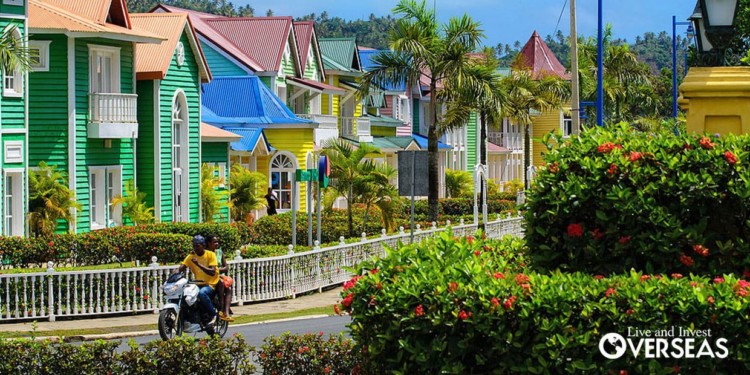A 12-year expat in Las Terrenas, Larry Stroup is a central figure in the expat social scene in this small Dominican Republic beach town.
Larry’s originally from Ft. Lauderdale, so it wasn’t the great weather that attracted him to Las Terrenas; he enjoyed good weather back in Florida. What got Larry’s attention about this part of the DR is the cheap and relaxed lifestyle.
“It was Key West from 50 years earlier, back when people still wanted to go to Key West,” Larry remembers of his first impressions.
Larry wasted no time settling in. He met, fell in love, and married Rose, his Dominican wife, and the couple started a new family. Then they started a new business, CrossFit Sandbox, a passion project for Larry and the first and only personal training program in this small town.
Every day at 8 a.m., Larry and Rose head to Playa Las Ballenas with their medicine balls and yoga mats and spend an hour on the beach together warming up and setting up in the shade of palm trees. At 9 a.m. the day’s fitness class on the beach begins, sometimes with just a couple of regulars, sometimes with a large group of hotel guests.
Larry first came to the Dominican Republic on an extended vacation and in his mid-40s. Like most tourists, he landed on the overdeveloped coastline of the Puerto Plata province, specifically in small-town Cabarete, the most Americanized town in the country.
Larry came for fun and wasn’t disappointed. When it came time to leave, he realized he didn’t want to… but he also knew that he didn’t want to stick around just for the party. He wanted to build a real, sustainable life in the Dominican Republic. Cabarete and Puerto Plata were not the place to do that.
Larry asked around and heard wonderful things about Las Terrenas, a tiny, mostly French, fishing town in the Samaná province. It sounded like the right fit, so Larry rented a motorcycle and headed across the island. His arrival story is one of the most entertaining and unique in the town’s history…
Having heard that Las Terrenas was about a two-hour drive from Cabarete, Larry set off down a highway that was little more than a dirt road at the time with little more than the clothes on his back.
About four hours later, he was nearing the turnoff for Las Terrenas when a pack of wild horses raced out of the jungle and into the road. Larry and his bike collided with the lead horse (who wasn’t harmed), leaving him and his bike badly torn up. Folks ran out to help Larry up and out of the road. Nowhere was closer than Las Terrenas for medical care, so that’s where Larry continued on to.
Larry took the turnoff and headed up what was then a treacherous mountain path, bounded by sheer cliff on one side and untouched jungle on the other. This mountain road used to be the only access into town and was heavily signposted with peligroso (danger) signs that Larry wasn’t yet able to decipher.
Slowing to a crawl, he began to doubt this crazy adventure—what had made him think this was a good idea? Injured and dehydrated, Larry was thinking of turning back… when, finally, the path crested on the mountain, and the sea began to peek through the landscape.
“It was one of the most beautiful sights I’ve ever seen, then or since,” Larry remembers. “I took it as a sign. Everything would be OK, and the trip was worth it.”
Finally reaching Las Terrenas, Larry stopped at the first inn he found, run by a German woman who nursed him back to health. He spent three days unconscious in bed, a few more gaining strength, then sped himself back Stateside.
Once back home, Larry packed up his old life then headed right back down to Las Terrenas, where he has spent the last 12 years building his new life.
Larry points out that his main drawback to the Dominican Republic is that the local economy is not robust enough for him to earn as much as he wants to earn locally. His CrossFit enterprise is more for fun than profit. He continues to rely on income he earns from the internet business he has continued operating in the States. With this cash flow, life in Las Terrenas is very comfortable.
Most couples live well on about US$1,500 a month, saying they buy imported foods, eat and drink out often, and never deprive themselves of small luxuries and indulgences. Most say they couldn’t imagine spending more than US$3,000 a month, even if buying only the most expensive of everything, eating out for every meal, and running air conditioning around the clock.
For a young family like Larry’s, US$2,500 a month is a good budget. Larry admits he and his family could never live on that in the United States, but it’s effortless to live on that or less here.
As he relocated from a beach town in Florida, I was curious how Larry would compare his current lifestyle with his former lifestyle in Ft. Lauderdale. He walked me through it…
“I paid US$1,200 a month for a small, one-bedroom apartment in an old building about a 10-minute drive from a beach that I never visited. What was the point? I had to fight through traffic to get there and pay US$10 to park, I couldn’t have a beer or a cigarette on the beach, couldn’t walk my dogs on the beach either. If I wanted lunch I’d pay US$40 for crap. There were so many hidden costs and restrictions, it seemed pointless.
“Now I live in a three-bedroom house off the water that I own. I am a two-minute walk from the beach where my wife, my son, and I can play in the sand with our dogs.”
Of course, it’s not all palm trees and beach fun…
“One big adjustment for me,” Larry says, “has been the difference in standards between North America and the rest of the world.”
When Larry built his brick-and-mortar gym in Las Terrenas (the one he uses when he’s not hosting class on the beach) he realized just how deep these differences can run. What works for a Dominican does not work for an American.
“While painting the gym,” Larry remembers, “my workers suggested that instead of buying more of the same green they had started with that they would finish with this other green they had a few cans of leftover. Two greens, one room. That works for a Dominican, but it doesn’t cut it for a North American.
“Instead of using wire ties to tie up loose ends, the workers wanted to use tape. Tape was available, ties weren’t. Why buy more paint when we already have some? Why buy ties when we’ve got tape?”
As Larry continues, “Common sense is not universally common. To get things done—the way you want them done—is not easy. Constant supervision and management are key. This goes for building a business or building a home.”
In his mid-50s now, Larry has no intention of slowing down. With his internet business booming back in the United States, his pet project in full swing in Las Terrenas, and his family with him every step of the way, Larry feels like he’s really only just getting started.
Kat Kalashian











